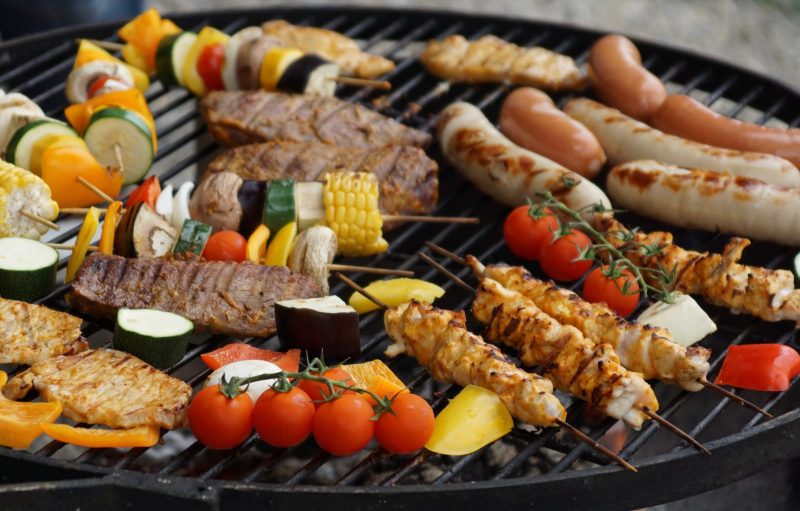
As we prepare for Independence Day celebrations, Virginia Tech food safety specialist Melissa Wright has advice for those hosting or attending backyard cookouts and potlucks.
To protect yourself, your family, and friends from foodborne illness during warm-weather months, safe food handling when eating outdoors is critical. Consider these four guidelines: clean, separate, cook, control.
CLEAN: Food safety begins with clean hands and surfaces, even in an outdoor setting. Before beginning your food prep, practice good hand-washing hygiene. If you do not have access to running water, simply use a water jug, some soap and paper towels. Proper hand cleaning is as much about the scrubbing action as it is about the soap. Make sure your eating surface is clean before setting out your dishes. If the surface is not cleanable, consider using disposable tablecloths.
SEPARATE: If you are transporting raw and ready-to-eat (RTE) foods, do so in separate coolers. Consider using coolers with white lids, since they will reflect light and heat rather than absorbing them.
Raw meats, poultry and seafood – Be sure to keep these items securely wrapped and separated from other foods. This keeps their juices from contaminating prepared/cooked foods or foods that will be eaten raw. All raw meat should be kept in a cooler at 40°F or below until time for grilling. Packing these items while still frozen can ensure they stay colder longer.
Raw fruits and vegetables – Rinse fresh fruits and vegetables under running tap water before packing them in the cooler, including those with skins and rinds that are not eaten. Rub firm-skinned fruits and vegetables under running tap water or scrub with a clean vegetable brush while rinsing with running tap water. Dry fruits and vegetables with a clean cloth towel or paper towel before packing.
Prepared cold dishes – Foods like pasta salad, deviled eggs, cut produce and many desserts require cold holding to maintain their safety. Transport them in a cooler with ice or frozen gel packs to maintain a temperature of less than 40°F. Remove them immediately before time to serve.
Prepared hot dishes – Hot food should be kept hot, at or above 140°F. Wrap it well and place it in an insulated container until serving.
Beverages and condiments – Consider packing a separate cooler for these items so that the repeated opening of the cooler will not expose temperature-controlled foods to warm outdoor air temperatures. Maintaining beverages and most purchased condiments (even mayonnaise!) at cool temperatures is for quality, not safety.
COOK: Grilling and picnicking often go hand-in-hand. Just like cooking indoors, there are important guidelines that should be followed to ensure that your grilled food reaches the table safely.
Marinate safely – Marinate foods under refrigeration – never on the kitchen counter or outdoors. In addition, if you plan to use some of the marinade as a sauce on the cooked food, reserve a portion separately before adding the raw meat, poultry, or seafood. Don’t reuse marinade that has touched raw meat or poultry.
Cook food thoroughly – When it’s time to cook the food, have your food thermometer ready. Always use it to be sure your food is cooked thoroughly by measuring the internal temperature at the thickest part of the food.
Whole steaks, roasts, pork and fish: 145°F
Ground meat: 160°F
Poultry (ground or whole): 165°F
Don’t cross-contaminate – Don’t reuse platters or utensils that held raw meat, poultry or seafood for serving unless they have been washed first in hot, soapy water. Using the same platter or utensils that previously held raw meat, poultry, or seafood allows bacteria from the raw food’s juices to spread to the cooked food. Instead, have a clean platter and utensils ready at grill-side to serve your food.
CONTROL (THE TEMPERATURE): Keeping food at proper temperatures – indoor and out – is critical in preventing the growth of foodborne bacteria. The key is to never let your picnic food remain in the “Danger Zone” – between 40°F and 140°F – for more than 2 hours (or 1 hour if outdoor temperatures are above 90°F.) This is when bacteria in food can multiply rapidly, and lead to foodborne illness.
Keep cold food cold – Cold foods in individual serving dishes can be placed directly on ice on your picnic table or in a shallow container set in a deep pan filled with ice. Drain off water as ice melts and replace ice frequently. Once you’ve served these dishes, they should not sit out for longer than 2 hours (or 1 hour if the outdoor temperature is above 90°F.) If food is left out longer, throw it away to be safe.
Keep hot food hot – Grilled food can be kept hot until served by moving it to the side of the grill rack, just away from the coals. This keeps it hot but prevents overcooking. Hot dishes like casseroles can be held in insulated carrying cases on the picnic table to keep them warm. Just as with cold food, these foods should not sit out for more than 2 hours (or 1 hour in temperatures above 90°F.) If food is left out longer, throw it away to be safe.
Melissa Wright is director of the Food Producer Technical Assistance Network in the department of Food Science and Technology at Virginia Tech.
Shannon Andrea for Virginia Tech


